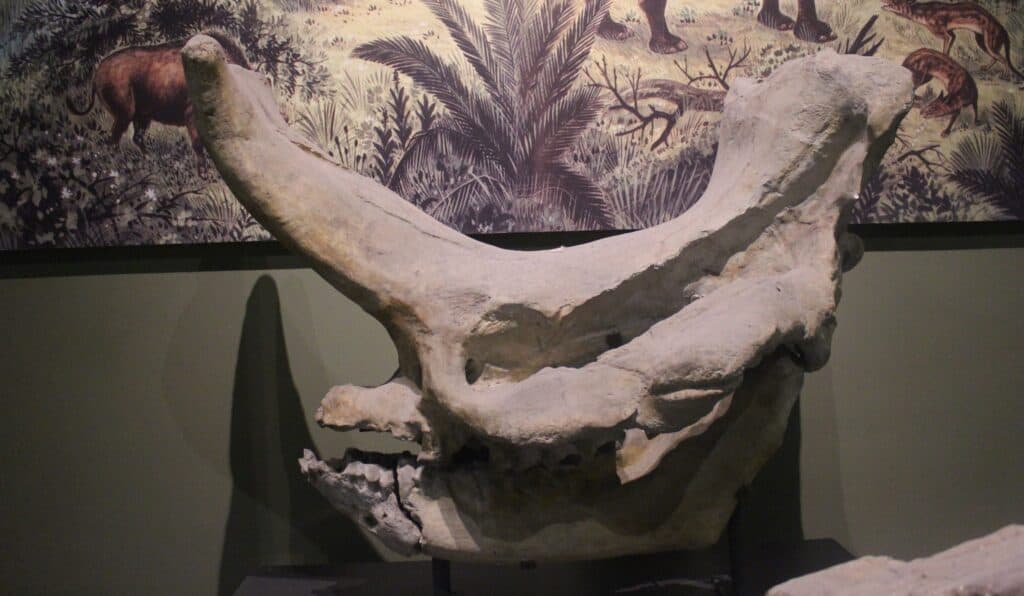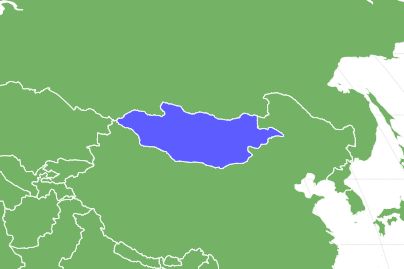Embolotherium had a ram on its snout like a rhino but they never used it as a weapon.
Advertisement
Embolotherium Scientific Classification
- Kingdom
- Animalia
- Phylum
- Chordata
- Class
- Mammalia
- Order
- Perissodactyla
- Family
- Brontoteriidae
- Genus
- Embolotherium
- Scientific Name
- Embolotherium andrewsi
Read our Complete Guide to Classification of Animals.
Embolotherium Conservation Status
Embolotherium Facts
- Fun Fact
- Embolotherium had a ram on its snout like a rhino but they never used it as a weapon.
- Biggest Threat
- Climate change
- Most Distinctive Feature
- Embolotherium had a long protruding snout
- Distinctive Feature
- Embolotherium had tough skin
- Habitat
- Wetlands and swamps
- Diet
- Herbivore
- Special Features
- Embolotherium had a large protruding snout which they used to signal each other
- Number Of Species
- 2
- Location
- Mongolia
View all of the Embolotherium images!
Embolotherium is a genus of heavily built mammals that lived in Mongolia during the late Eocene Epoch. While paleontologists have still been unable to find a complete fossilized skeleton of this animal, a few skull and jaw bones have been found. They had rams on their snouts like a rhino. However, this was probably ornamental as it was not used for defense or intraspecies conflict.
Description and Size
Embolotherium is an extinct mammal that lived during the Eocene Epoch about 41 to 34 million years ago. The name Embolotherium means “wedge beast” or “battering ram beast,” so named because of the prominent bony plate that extends from the tip of its snout.
Embolotherium was a brontothere. This is a family of extinct mammals superficially built like rhinos but more closely related to horses. However, unlike other brontotheres that tend to have some sort of horn on their head, Embolotherium had a large protruding snout that looked like a battering ram. Interestingly, this plate was lightweight and hollow. This means, contrary to the name, this mammal didn’t use its bony plate to batter anything. Instead, experts think it was a type of specialized resonator that they used to signal each other.
Embolotherium was one of the biggest members of the Brontotheriidae family. It was about eight feet tall and up to 16 feet long. The massive beast weighed up to 4400 pounds. It has been difficult to reconstruct the appearance of this mammal because remains found so far have been fragmented. However, compared to other brontotheres, Embolotherium probably had a bulky build similar to modern rhinoceros.
Embolotherium was hardly a bright animal. It had a small brain that was no bigger than an orange. There is no evidence to date that depict whether it was sexually dimorphic or not. Its teeth were seemingly built for shearing and not necessarily grinding.
Scientists have named several species of Embolotherium. However, only two of these species are recognized as valid. They are Embolotherium andrewsi and Embolotherium grangeri.

had a large protruding snout that looked like a battering ram but was in fact lightweight and hollow.
©Jonathan Chen / CC BY-SA 4.0 – License
History and Evolution
Embolotherium belongs to a group of mammals in the same order as present-day horses, tapirs, and rhinoceroses. This group evolved about 56 million years ago and went extinct around the close of the Eocene about 36 million years ago. Embolotherium was an Asian genus and is often compared to the North American variety, Megacerops, in terms of size.
In the early days of their evolution, members of this family were rather small in size. Primitive brontotheres like the Eotitanops were only 1.48 feet in height. However, over the course of the Eocene, they evolved into more massive sizes.
The ornamental skull accessories, such as the horns and skull plates, were adaptations they developed later. In some species, the horns were used as weapons for defense and intra-species competition for mates. However, Embolotherium developed less rigid bony skull protrusions that served a different purpose altogether.
Diet — What Did Embolotherium Eat?
This animal was a herbivore. Their dentition looked like it was adapted for cutting relatively soft and non-abrasive vegetation. They had “w”-shaped molars adapted for shearing plants rather than grinding them. They also had poorly-developed forward incisors. Their diet likely consisted of soft plants that could be pulled easily and did not require a lot of effort to chew.
Habitat — When and Where Embolotherium Lived
Embolotherium lived in Mongolia during the late Eocene Epoch, between 41 and 34 million years ago. Fossils have been found specifically in the Gobi Desert of Mongolia. Incomplete fossils have also been discovered in China, which suggests that there is a possibility the animal lived there during the Eocene.
It is important to note that the climate in Mongolia and the rest of Asia was different from what we have today. The Gobi Desert area where this animal was found was at a lower elevation. This means the area had an abundance of wetlands and swamps. This was most likely the Embolotherium’s preferred habitat at the time.

lived in Mongolia during the late Eocene Epoch with fossils found specifically in the Gobi Desert.
©mr.wijannarongk kunchit/Shutterstock.com
Threats and Predators
Although it was not a predator, Embolotherium had an intimidating size and tough skin. These features would have protected it from any predators around. Later on, environmental changes such as climate change would become a major threat to its existence. Towards the end of the Eocene, the Himalayan Mountains began to rise, elevating the land. This made the low-lying swamps where this mammal lived drier and created an unsuitable environment for them.
Discoveries and Fossil — Where Embolotherium Was Found
Conclusions about the appearance and habits of the Embolotherium are based on comparison with other brontotheres with more complete fossil remains. This is because, so far, scientists have not yet found a complete skeleton of the Embolotherium. Only skull and jaw bones, as well as a few other skeletal elements, have been found.
The major sites of the animal’s discovery include the Ulan Gochu Formation and Irgilin Dzo Formation, located in Inner and Outer Mongolia, respectively. The animal was discovered in Mongolia for the first time between the 1924 and 1925 seasons. American paleontologist Henry Fairfield Osborn named the species in 1929.
Beyond Mongolia, a few brontothere fossils have been found in the Maoming Basin, Guangdong Province, China. Paleontologists used this particular fossil discovery to decipher the true dentition of the creature.
Extinction — When Did the Embolotherium Die Out?
Many researchers consider Embolotherium one of the most successful brontothere representatives of the Eocene age. All brontotheres in North America and Asia went extinct at the end of the Eocene due to climate change. The rise of the Himalayan Mountains raised the general elevation of the area, and this reduced the amount of moisture in the environment. The dry climate created extensive plains instead of the swampy lowlands that this animal was used to living in.
The plants in this highly modified landscape were alien to the Embolotherium as well. It was natural that the environmental shift and change in vegetation brought in new species of herbivores that quickly adapted to changing environments and outcompeted the Embolotherium.

The rise in elevation of the Himalayan Mountains created a drier climate that was unsuitable for the
Embolotherium.
©bodrumsurf/Shutterstock.com
Similar Animals to the Embolotherium
Similar animals to the Embolotherium include:
- Megacerops — This is an extinct brontothere genus that lived in North America during the Late Eocene. It is roughly the same size as the Embolotherium. However, it had prominent horns on its head, which were used as a weapon.
- Sphenocoelus — This is a genus of brontothere that lived in North America during the Middle Eocene Epoch (about 46.2 to 40.4 million years ago). It was smaller in size compared to other brontotheres that evolved later in the Eocene, such as the Embolotherium.
- Rhinoceros — Embolotherium was distantly related to rhinos. They had a similar build, and they both belong to the order Perissodactyla.
Related Animals
View all 117 animals that start with EEmbolotherium FAQs (Frequently Asked Questions)
When was Embolotherium alive?
Embolotherium was alive during the Eocene Epoch, which ended 33.9 million years ago. It was highly perceived as one of the most successful herbivores during that period. It engaged in group herding and largely avoided predators due to its tough skin. Environmental changes led to its extinction.
How big was the Embolotherium?
It was as big as a modern-day rhino. It weighed up to 4400 pounds and was as long as 16 feet. The massive mammal stood at about 8 feet in height. Embolotherium ranks as one of the biggest mammals of the Eocene age.
How did the Embolotherium feed?
The creature was herbivorous with a delicate dentition that was better suited for eating soft vegetation.
Why did Embolotherium go extinct?
Climate change, coupled with the rise of more competitive and fast-adapting herbivores in its ecosystem, forced the Embolotherium into extinction by the end of the Eocene age.
Thank you for reading! Have some feedback for us? Contact the AZ Animals editorial team.
Sources
- Wikipedia, Available here: https://en.wikipedia.org/wiki/Embolotherium
- Prehistoric Wildlife, Available here: http://www.prehistoric-wildlife.com/species/e/embolotherium.html
- Wikipedia, Available here: https://en.wikipedia.org/wiki/Brontotheriidae

















